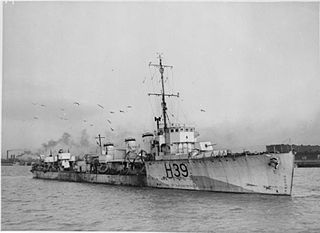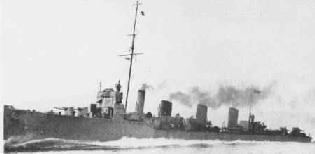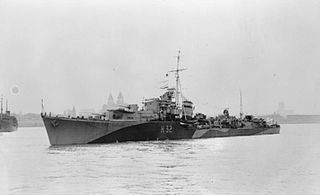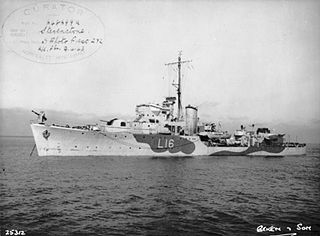
The Royal Navy (RN) is the naval warfare force of the United Kingdom, British Overseas Territories and Crown Dependencies, and a component of His Majesty's Naval Service. Although warships were used by English and Scottish kings from the early medieval period, the first major maritime engagements were fought in the Hundred Years' War against France. The modern Royal Navy traces its origins to the English Navy of the early 16th century; the oldest of the UK's armed services, it is consequently known as the Senior Service.

The Grand Fleet was the main battlefleet of the Royal Navy during the First World War. It was established in August 1914 and disbanded in April 1919. Its main base was Scapa Flow in the Orkney Islands.

The S and T class was a class of sixteen destroyers of the Royal Navy launched in 1942–1943. They were built as two flotillas, known as the 5th and 6th Emergency Flotilla, and they served as fleet and convoy escorts in World War II.

The River class was a class of 151 frigates launched between 1941 and 1944 for use as anti-submarine convoy escorts in the North Atlantic. The majority served with the Royal Navy and Royal Canadian Navy (RCN), with some serving in the other Allied navies: the Royal Australian Navy (RAN), the Free French Naval Forces, the Royal Netherlands Navy and, post-war, the South African Navy.

HMS Bramham (L51) was a Hunt-class destroyer of the Royal Navy laid down in Alexander Stephen and Sons shipyards Govan, Scotland on 7 April 1941. She was launched on 29 January 1942 and commissioned into the Royal Navy on 16 June 1942. She was named after the Bramham Moor Hunt and has been the only Royal Navy warship to bear the name. She was adopted by the town of Beverley in the East Riding of Yorkshire during the Warship Week savings campaign of 1942.

HMS Challenger was a Pearl-class corvette of the Royal Navy launched on 13 February 1858 at the Woolwich Dockyard.

The Laforey class was a class of 22 torpedo boat destroyers of the Royal Navy, twenty of which were built under the Naval Programme of 1912–13 and a further two under the 2nd War Emergency Programme of 1914. As such they were the penultimate pre-war British destroyer design. All served during World War I during which three were lost; the survivors were all scrapped in 1921-23.

Ships of the Royal Navy is a naval history reference work by J. J. Colledge (1908–1997); it provides brief entries on all recorded ships in commission in the Royal Navy from the 15th century, giving location of constructions, date of launch, tonnage, specification and fate.

A infantry landing ship was one of a number of types of British Commonwealth vessels used to transport landing craft and troops engaged in amphibious warfare during the Second World War. LSIs were operated by the Royal Navy, British Merchant Navy, Royal Canadian Navy, Royal Indian Navy, and Royal Australian Navy. They transported British Commonwealth and other Allied troops in sea assaults and invasions throughout the war.

The first R class were a class of 62 destroyers built between 1916 and 1917 for the Royal Navy. They were an improvement, specifically in the area of fuel economy, of the earlier Admiralty M-class destroyers. The most important difference was that the Admiralty R class had two shafts and geared turbines, compared with the three shafts and direct turbines of the Admiralty M class, but in appearance the R class could be distinguished from its predecessors by having the after 4-inch gun mounted in a bandstand. The Admiralty ordered the first two of this class of ships in May 1915. Another seventeen were ordered in July 1915, a further eight in December 1915, and a final twenty-three in March 1916.

The Faulknor class were a class of flotilla leaders that were under construction in the United Kingdom for the Chilean Navy at the outbreak of World War I. Six ships were ordered by Chile, of which the first two were delivered to Chile before the outbreak of the war. The remaining four ships were purchased by the British, taken over and completed for the Royal Navy for wartime service. In common with Royal Navy convention, they were named after famous Royal Navy captains of the past, in this case the members of the Faulknor family.

The Medea class were a class of destroyers that were being built for the Greek Navy at the outbreak of World War I but were taken over and completed for the Royal Navy for wartime service. All were named after characters from Greek mythology as result of their Greek heritage.

HMS Verulam was an Admiralty V-class destroyer of the Royal Navy. She was built by Hawthorn Leslie and was launched on 3 October 1917. She struck a mine off the island of Seiskari in the Gulf of Finland on the night between 3–4 September 1919, and sank killing 16 crew.

HMS Rapid was an R-class destroyer of the Royal Navy that saw service during the Second World War and was sunk as a target in 1981.

HMIS Tir was a River-class frigate of the Royal Indian Navy (RIN). She was acquired from the Royal Navy where she served as HMS Bann during World War II. She was commissioned into the RIN in December 1945.

Miaoulis was a Type III Hunt-class destroyer that was originally built for the British Royal Navy as HMS Modbury but never commissioned. Before her completion, she was transferred to the Royal Hellenic Navy and commissioned on 25 November 1942 as Miaoulis in order to relieve heavy losses of ships sustained by the Royal Hellenic Navy during the German invasion of 1941. Miaoulis served in the Mediterranean Theatre throughout the Second World War. On 10 October 1943, during the Dodecanese Campaign, she saved the crew of the British destroyer HMS Panther. She served during the Greek Civil War, was returned to the Royal Navy in 1959 and broken up for scrap in 1960.

HMS Stevenstone was a Hunt-class destroyer of the Royal Navy. She was a member of the third subgroup of the class, and saw service in the Second World War. All the ships of this class were named after British fox hunts. She was the first Royal Navy warship with this name, after the Stevenstone hunt in Devon.
HMS Oxlip was a Flower-class corvette that served in the Royal Navy during World War II.

HMS Borage was a Flower-class corvette that served in the Royal Navy during World War II.

















